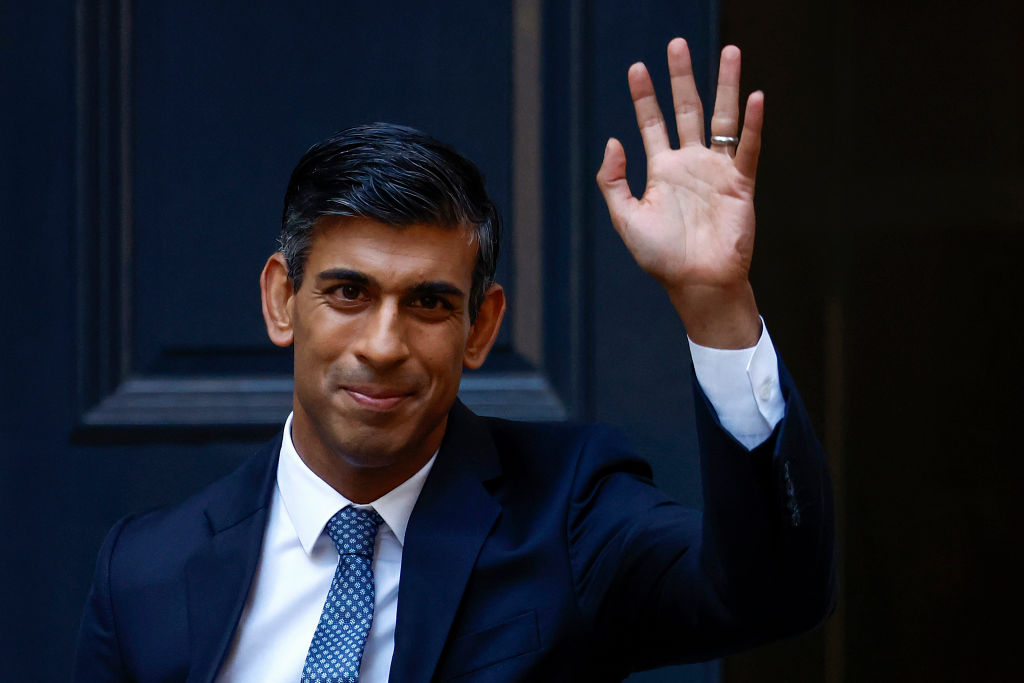In his speech in north London his morning, the Prime Minister confirmed that tax cuts are coming this Wednesday, as is another attempt by the government to get Britain’s 5.5 million missing workers back into employment. But Rishi Sunak didn’t stop there. Having achieved one of his five pledges for the year last week — the inflation rate halved in the year to October, slowing to 4.6 per cent — the Prime Minister decided this morning to offer up five more.
Now in addition to the ‘five promises’ made in January — halving inflation, growing the economy, reducing public debt, cutting NHS waiting lists and ‘stopping the boats’ (a pledge that broadly became defined as getting his Rwanda scheme off the ground) — we now also have ‘five long-term decisions’ for the economy. These include reducing the debt, cutting tax, creating a sustainable energy system, supporting British business and improving education. No small challenges, then.
It’s an ambitious move, not least because based on the metrics Sunak set himself — ‘judge us on the effort we put in and the results we achieve’, he said in January — those first four outstanding pledges need to be achieved in just under six weeks. The prime minister seems to have avoided that problem with his new set of promises by excluding a clear timeline, while also avoiding specific metrics. But even without putting a clear delivery date on his new pledges, it’s clear the first bunch aren’t going so well: growth is virtually non-existent, the NHS waiting list has risen by almost 700,000 additional appointments since January, public sector net debt is rising and there is no chance flights to Rwanda are getting off the ground anytime soon.
How will the public respond to five more challenges being set out, when most of the first round have not been met? Sunak’s second promise, to ‘turn our attention to cutting tax’ is going to be doing a lot of the heavy lifting. It appears he’ll be able to say he’s made good on this promise later in the week, when his Chancellor Jeremy Hunt delivers the Autumn Statement. It will be a relief to many, with the tax burden at nearly a post-war high, to be able to keep a bit more of what they earn. But even slashing tax may not prove as straightforward as the Prime Minister would like. While Sunak wouldn’t be drawn on the specifics of what will be announced on Wednesday, there is no guarantee that whatever is cut will offset the fiscal drag that has been taking place over the past few years, thanks to frozen tax thresholds. It’s hard to imagine a personal tax cut so bold this week that it dramatically shifts the overall tax burden.
How will the Prime Minister meet his promises? ‘Political courage’ was his answer, an echo of what he believes to be one of his biggest selling points: that unlike his opposition (or his predecessors) he is the one willing to make ‘tough decisions’.
But have all those difficult choices really been made? The government likes to argue that resisting demands to spend more money, especially around pay in the public sector, is a good example of sticking to principles. But the government has also been eager to commit to more spending promises and has avoided any radical decision-making in areas like healthcare that might get patients seen faster.
‘My argument has never been that we shouldn’t cut taxes’ said Sunak this morning. ‘It’s been that we can only cut taxes once we have controlled inflation and debt. First cut inflation, then cut taxes.’
Debt hasn’t been controlled. And with the inflation rate still more than double the Bank of England’s target, inflation is by no means done and dusted with. Yet this was the most compelling case the Prime Minister managed this morning for making a new set of pledges. It is unlikely to stop people asking: what’s happening with the first set?







Comments